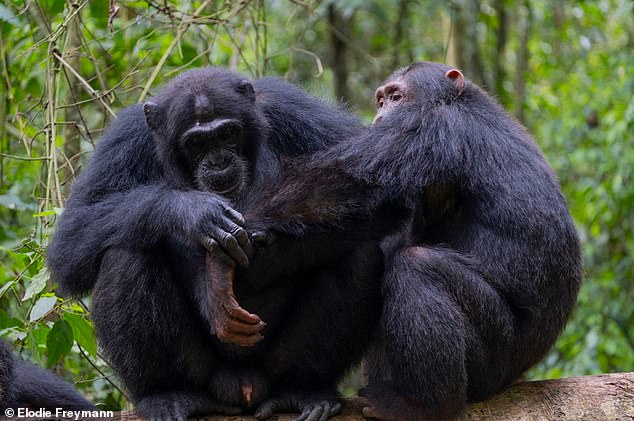Chimpanzees are among our closest living relatives, but they may be even more like us than we realised.
In fact, in the animal kingdom, it seems chimps perform crucial first aid too.
Scientists have observed chimps in Uganda cleaning and treating not only their own wounds, but those of other chimps.
In a fascinating video, a young chimpanzee cares for a wound on his left knee with chewed stem bark and fresh leaves.
In another clip, a young female licks her fingers and applies them to her mother’s wound after an attack.
Chimps helping others with their injuries – known as ‘prosocial wound care’ – has been documented before at other sites.
But Dr Elodie Freymann, a primate researcher at the University of Oxford who led the observations in Uganda, said it is ‘very rare’ behaviour.
‘The presence of prosocial care at this site demonstrates that this kind of prosocial healthcare is more widespread than we previously thought,’ she told MailOnline.

Scientists studying chimpanzees in Budongo Forest, Uganda, have observed that these primates don’t just treat their own injuries, but care for others, too

For chimps, helping each other with wounds isn’t just something that family members do. Pictiured, social grooming between two chimpanzees in the Budongo Forest, Uganda
She continued: ‘Our research helps illuminate the evolutionary roots of human medicine and healthcare systems.
‘By documenting how chimpanzees identify and utilize medicinal plants and provide care to others, we gain insight into the cognitive and social foundations of human healthcare behaviours.’
Humans and chimpanzees are both great apes (Hominidae) and chimps are our closest animal cousins, along with bonobos.
Dr Freymann and colleagues studied two communities of chimps in the Budongo Forest that are known as Sonso and Waibira.
Like all chimps, members of these communities are vulnerable to injuries, whether caused by fights and accidents, or as a result of human traps.
About 40 per cent of individuals in Sonso have been seen with injuries from ‘snares’ – essentially a noose made of wire or rope that catch animals around the neck or body.
After four months of observing each community, the scientists recorded 12 injuries in Sonso (all of which were likely caused by within-group conflicts) and five in Waibira (one female injured by a snare, and four males injured in fights).
Overall, researchers documented 41 cases of care: seven cases of care for others (known as prosocial care) and 34 cases of self-care.

Chimps elsewhere have been observed helping other community members with medical problems. But persistent presence of this behaviour in Budongo suggests medical care among chimps is much more widespread than we realised, and not confined to care for close relatives

Social bonding behaviours in chimpanzees, like grooming and play, can spread through groups much like contagious yawns or laughter in humans, according to prior research
Of the seven instances of prosocial care, the researchers found four cases of wound treatment, two cases of snare removal assistance, and one case where a chimp helped another with hygiene.
Care wasn’t preferentially given by, or provided to, one sex or age group, suggesting it’s widespread among the species.
On four occasions, care was given to genetically unrelated individuals – suggesting that there’s no direct genetic advantage to it, but rather a social one.
According to Dr Freymann, methods of applying the so-called ‘first aid’ can vary depending on the individual and their injury.
‘Chimpanzee wound care encompasses several techniques – direct wound licking, which removes debris and potentially applies antimicrobial compounds in saliva; finger licking followed by wound pressing; leaf-dabbing; and chewing plant materials and applying them directly to wounds,’ she said.
‘All chimpanzees mentioned in our tables showed recovery from wounds, though of course we don’t know what the outcome would have been had they not done anything about their injuries.
‘We also documented hygiene behaviours, including the cleaning of genitals with leaves after mating and wiping the anus with leaves after defecation – practices that may help prevent infections.
‘These behaviours add to the evidence from other sites that chimpanzees appear to recognize need or suffering in others and take deliberate action to alleviate it, even when there’s no direct genetic advantage.’

The researchers say it is not clear how the chimpanzees learn to eat the plants. However, they note that some of the more complex behaviour is likely to be socially learned rather than instinctual

Dr Elodie Freymann (pictured) from the University of Oxford thinks chimpanzees appear to recognize need or suffering in others
Dr Freymann and colleagues have already shown that sick and injured chimpanzees ‘self-medicate’ by eating medicinal plants at Budongo Forest.
Chimps elsewhere have been observed helping other community members with medical problems – for example, the application of insects to wounds in Loango National Park, Gabon.
But persistent presence of this behaviour in Budongo suggests medical care among chimps is much more widespread than we realised, and not confined to care for close relatives.
The scientists call for more research into the social and ecological contexts in which care takes place, and which individuals give and receive care.
One possibility is high risk of injury and death which Budongo chimps all face from snares could increase the likelihood that these chimps care for each other’s wounds.
The study, published in the journal Frontiers in Ecology and Evolution, follows other demonstrations of altruistic behaviour in other animals.
Anecdotal observations of various animal species in the wild including dolphins and elephants have documented helpful actions towards peers that have collapsed as a result of sickness, injury or death, including touching, grooming and nudging.
Earlier in the year, another team of researchers published video of a mouse giving ‘first aid’ to an unconscious companion.
In the adorable lab footage, one of the rodents opens an unconscious partner’s mouth and pulls its tongue aside to clear its airway.
This article was originally published by a www.dailymail.co.uk . Read the Original article here. .

